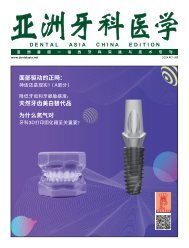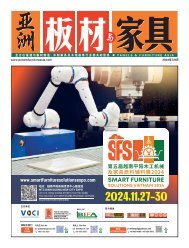Dental Asia May/June 2018
For more than two decades, Dental Asia is the premium journal in linking dental innovators and manufacturers to its rightful audience. We devote ourselves in showcasing the latest dental technology and share evidence-based clinical philosophies to serve as an educational platform to dental professionals. Our combined portfolio of print and digital media also allows us to reach a wider market and secure our position as the leading dental media in the Asia Pacific region while facilitating global interactions among our readers.
For more than two decades, Dental Asia is the premium journal in linking dental innovators
and manufacturers to its rightful audience. We devote ourselves in showcasing the latest dental technology and share evidence-based clinical philosophies to serve as an educational platform to dental professionals. Our combined portfolio of print and digital media also allows us to reach a wider market and secure our position as the leading dental media in the Asia Pacific region while facilitating global interactions among our readers.
- No tags were found...
You also want an ePaper? Increase the reach of your titles
YUMPU automatically turns print PDFs into web optimized ePapers that Google loves.
Behind the Scenes<br />
in the ve Vita system 3D-master shades<br />
0M1, 1M1, 1M2, 2M2 and 3M2 (Fig. 3). Shade<br />
determination in accordance with this<br />
scientically-substantiated shade system<br />
is recommended, not just for this reason,<br />
but in general.<br />
I n o u r p r a c t i c e , w e u s e t h e<br />
Vita Toothguide 3D-master (Fig. 4) for this<br />
purpose; alternatively, the Vita Linearguide<br />
3D-master can be used as well.<br />
To facilitate digital verification, our<br />
practice uses the Vita Easyshade Advance 4.0<br />
shade measurement device.<br />
Fig. 8: Image of the<br />
buccal view with<br />
teeth clenched<br />
Fig. 12: Final virtual model following calculation<br />
Fig. 9: The three<br />
images...<br />
Fig. 5: Prepared tooth following removal of caries<br />
In this example, the relevant shade for<br />
the patient was 2M2. It has been shown that<br />
in case of doubt, a level brighter rather than<br />
a level darker is always preferable. It must<br />
be taken into consideration that the greater<br />
the wall thickness of the restoration, the<br />
more intensive or darker the shade eect<br />
will be. In regards to inlay restorations, the<br />
HT variant should generally be used.<br />
In the next step, the caries in tooth<br />
UR6 is removed and prepared (Fig. 5).<br />
Fig. 6: Image of<br />
the prepared<br />
quadrant<br />
Fig. 10: ... are correlated with one another<br />
Preparation is performed in accordance with<br />
the established guidelines for all-ceramic<br />
restorations. Impression-taking is carried<br />
out digitally using Cerec Omnicam (Sirona).<br />
Figures 6 to 10 show images of the<br />
preparation, antagonist and nal bite as<br />
well as the correlation of the three model<br />
elements. Following determination of the<br />
model axis, the fully-calculated virtual<br />
model was ready in V 4.24 of the Cerec<br />
software (Fig. 11-13) for the design phase.<br />
Fig. 13: Dened preparation margin and setting<br />
the insertion axis<br />
The suggested design was conrmed<br />
and, as a nal step, veried in the milling<br />
preview (Fig. 14-15). For fabrication using<br />
the Cerec MC XL milling machine, the EM-10<br />
block geometry measuring 8 x 10 x 15 mm<br />
was selected, which is only available in HT.<br />
EM-14 measures 12 x 14 x 18 mm.<br />
Fig. 14: Suggested design, showing the occlusal<br />
contacts<br />
Fig. 7: Image of<br />
the antagonist<br />
Fig. 11: Determining the model axis<br />
Fig. 15: Inlay construction in the milling preview<br />
DENTAL ASIA<br />
MAY / JUNE <strong>2018</strong><br />
55


















